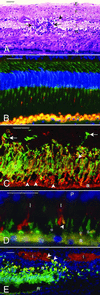The nuclear receptor NR2E3 plays a role in human retinal photoreceptor differentiation and degeneration
- PMID: 11773633
- PMCID: PMC117584
- DOI: 10.1073/pnas.022533099
The nuclear receptor NR2E3 plays a role in human retinal photoreceptor differentiation and degeneration
Abstract
Normal human retinal development involves orderly generation of rods and cones by complex mechanisms. Cell-fate specification involves progenitor cell lineage and external signals such as soluble factors and cell-cell interactions. In most inherited human retinal degenerations, including retinitis pigmentosa, a mutant gene causes loss of visual function, death of mature rods, and eventually death of all cone subtypes. Only one inherited retinal disorder, the enhanced S cone syndrome (ESCS), shows increased visual function, involving the minority S (blue) cones, and decreased rod and L/M (red/green) cone function. This autosomal recessive disease is caused by mutations in NR2E3, a photoreceptor nuclear receptor transcription factor, and may result from abnormal cell-fate determination, leading to excess S cones at the expense of other photoreceptor subtypes. In 16 ESCS patients with the most common NR2E3 mutation, R311Q, we documented an abnormal ratio of S to L/M cone function and progressive retinal degeneration. We studied the postmortem retina of an ESCS patient homozygous for NR2E3 R311Q. No rods were identified, but cones were increased approximately 2-fold, and 92% were S cones. Only 15% of the cones expressed L/M cone opsin, and some coexpressed S cone opsin. The retina was disorganized, with densely packed cones intermixed with inner retinal neurons. The retina was also degenerate, retaining photoreceptors in only the central and far peripheral regions. These observations suggest a key role for NR2E3 in regulation of human photoreceptor development. Degeneration of the NR2E3 retina may result from defective development, known S cone fragility, or abnormal maintenance of mature photoreceptors.
Figures



References
-
- Livesey F J, Cepko C L. Nat Rev. 2001;2:109–118. - PubMed
-
- Rothermel A, Layer P G. Eur J Neurosci. 2001;13:949–958. - PubMed
-
- Johnson P T, Williams R R, Reese B E. Visual Neurosci. 2001;18:157–168. - PubMed
-
- Egea P F, Klaholz P, Moras D. FEBS Lett. 2000;476:62–67. - PubMed
-
- Kumar R, Thompson E B. Steroids. 1999;64:310–319. - PubMed
Publication types
MeSH terms
Substances
Grants and funding
LinkOut - more resources
Full Text Sources
Other Literature Sources
Molecular Biology Databases

